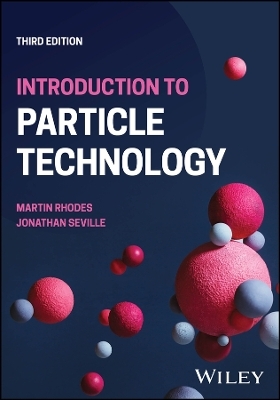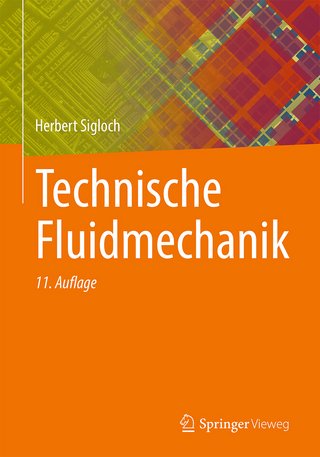
Introduction to Particle Technology
John Wiley & Sons Inc (Verlag)
978-1-119-93110-2 (ISBN)
Particle technology concerns the formation, processing and properties of the particles and powders which make up many of the products that surround us. Such products range from the cement and aggregate in the built environment to pharmaceuticals and processed foods. Most of the process industries involve particles, either as essential components such as catalysts or as intermediate or final products, and minerals such as the rare earths that are generally mined and processed in particulate form. Particles can have many beneficial uses but they can also cause harm in the environment and, through inhalation, to the individual. In all cases, the powder properties, particularly particle size, are crucially important.
This well-known textbook, now in its 3rd edition, provides an easily-understood introduction to the underlying scientific principles of particle technology, together with examples of how these principles can be used in practical design and operation of industrial processes. Each chapter contains both worked examples and exercises for the student. Based on feedback from students and users of the earlier editions, this revised and expanded text includes introductory chapters on particles as products and on computational methods. The topics have been selected to give coverage of the broad areas of particle technology and include:
Characterization (size analysis, surface area)
Processing (granulation, fluidization)
Particle formation (granulation, crystallisation, tableting, size reduction)
Storage and transport (hopper design, pneumatic conveying, standpipes)
Separation (filtration, settling, cyclones)
Safety (fire and explosion hazards, health hazards)
Engineering the properties of particulate systems to achieve desired product performance
Discrete element modelling of particulate systems
Introduction to Particle Technology, 3rd Edition is essential reading for students of chemical engineering. The text is also recommended reading for students of mechanical engineering, applied chemistry, pharmaceutics, physics, mineral processing, and metallurgy, and is an excellent source for practising engineers and scientists looking to establish a working knowledge of the subject.
Martin Rhodes, PhD, is Professor Emeritus in the Department of Chemical and Biological Engineering, Monash University, Australia and has published extensively on particle technology. Jonathan Seville, PhD, is Professor of Formulation Engineering at the School of Chemical Engineering, University of Birmingham, UK. Formerly editor of the journal Powder Technology, he has published several books on particle technology. He is past President of the Institution of Chemical Engineers and a Fellow of the Royal Academy of Engineering.
About the Authors xi
Preface to the Third Edition xii
Preface to the Second Edition xiii
Preface to the First Edition xiv
Acknowledgements xvii
About the Website xviii
Introduction xix
1 Particle Analysis 1
1.1 Particle Size 1
1.2 Description of Populations of Particles 4
1.3 Conversion Between Distributions 4
1.4 Describing the Population by a Single Number 7
1.5 Equivalence of Means 9
1.6 Common Methods of Displaying Size Distributions 11
1.6.1 Normal Distribution 11
1.6.2 Log-normal Distribution 11
1.7 Methods of Particle Size Measurement 12
1.7.1 Image Analysis 13
1.7.2 Light Scattering 13
1.7.3 Dynamic Light Scattering 15
1.7.4 Scanning Mobility Particle Sizer 15
1.7.5 Other Methods 16
1.8 Surface Area Measurement 17
1.8.1 Adsorption Isotherms 17
1.8.2 The BET Technique 17
1.9 Sampling 19
1.10 Worked Examples 19
Test Yourself 28
Exercises 29
2 Mechanical Properties of Particles 32
2.1 Introduction to Material Properties 33
2.2 Particle–Particle Contact for Elastic Materials 36
2.3 Contact in the Presence of Surface Forces 38
2.3.1 Cohesion and Adhesion 38
2.3.2 Surface Roughness and Contamination 41
2.3.3 Comparison of Cohesion with Particle Weight 41
2.3.4 Measurement of Cohesion and Adhesion 42
2.4 Friction 43
2.5 Impact and Bounce 45
2.5.1 Impacts in the Normal Direction 45
2.5.2 Oblique Impacts 47
2.6 Liquid Bridges 47
2.7 Worked Examples 52
Test Yourself 54
Exercises 54
3 Motion of Particles in a Fluid 56
3.1 Single Particles in a Fluid 56
3.1.1 Motion of Single Solid Particles in a Fluid 56
3.1.2 Particles Falling Under Gravity Through a Fluid 59
3.1.3 Effect of Boundaries on Terminal Velocity 63
3.1.4 Unsteady Motion 64
3.1.5 Further Reading 65
3.1.6 Worked Examples on the Motion of Single Particles in a Fluid 66
Test Yourself – Single Particles in a Fluid 74
3.2 Settling of a Suspension of Particles 75
3.2.1 Introduction 75
3.2.2 Settling Flux as a Function of Suspension Concentration 77
3.2.3 Sharp Interfaces in Sedimentation 79
3.2.4 The Batch Settling Test 80
3.2.5 Relationship Between the Height–Time Curve and the Flux Plot 83
3.2.6 Worked Examples on Settling of a Suspension of Particles 85
Test Yourself – Settling of a Suspension Particles 92
Exercises – Single Particles in a Fluid 92
Exercises – Settling of a Suspension of Particles 95
4 Discrete Element Method Modelling 102
4.1 Introduction 102
4.2 Principles – The “Hard-Sphere” and “Soft-Sphere” Approaches 104
4.3 Updating Particle Positions –‘Time-Stepping’ 107
4.4 Contact Detection 109
4.5 Contact Modelling 110
4.5.1 Linear Spring–Dashpot Model 111
4.5.2 Hertzian Model 112
4.5.3 Elastoplastic Models 112
4.5.4 Cohesive Models 113
4.6 Coupling with Computational Fluid Dynamics (CFD–DEM) 114
4.7 Calibration 115
4.8 Modelling Large Systems 118
4.9 Modelling Aspherical Particles 119
4.10 Data Analysis and Visualization 121
4.11 Validation 123
4.12 Worked Examples 124
Exercises 132
Interactive Exercises 132
5 Colloids, Aerosols and Fine Particles 133
5.1 Introduction 133
5.2 Brownian Motion 134
5.3 Surface Forces 136
5.3.1 van der Waals Forces 137
5.3.2 Electrical Double-Layer Forces 139
5.3.3 Adsorbing Polymers, Bridging and Steric Forces 144
5.3.4 Net Interaction Force 145
5.4 Effect of Surface Forces on Behaviour in Air and Water 145
5.5 Influences of Particle Size and Surface Forces on Solid/Liquid Separation by Sedimentation 148
5.5.1 Sedimentation Rate 148
5.5.2 Sediment Concentration and Consolidation 149
5.6 Gas–Solid Separation 151
5.7 Suspension Rheology 152
5.8 Influence of Surface Forces on Suspension Flow 157
5.8.1 Repulsive Forces 157
5.8.2 Attractive Forces 158
5.9 Nanoparticles 162
5.10 Worked Examples 163
Test Yourself 166
Exercises 167
6 Packed Beds and Fluidized Beds 170
6.1 Fluid Flow Through a Packed Bed of Particles 170
6.1.1 Pressure Drop–Flow Relationship 170
6.1.2 Further Reading 174
6.1.3 Worked Examples 174
Test Yourself – Fluid Flow through Packed Beds 176
6.2 Fluidization 176
6.2.1 Fundamentals 176
6.2.2 Relevant Powder and Particle Properties 179
6.2.3 Bubbling and Non-Bubbling Fluidization 181
6.2.4 Classification of Powders 183
6.2.5 Expansion of a Fluidized Bed 187
6.2.6 Entrainment 191
6.2.7 Heat Transfer in Fluidized Beds 195
6.2.8 A Simple Model for the Bubbling Fluidized Bed Reactor 201
6.2.9 High Velocity Fluidization 205
6.2.10 Some Practical Considerations 210
6.2.11 Applications of Fluidized Beds 213
6.2.12 Worked Examples 220
Test Yourself – Fluidization 226
Exercises – Fluid Flow through Packed Beds 227
Exercises – Fluidization 228
7 Pneumatic Transport and Standpipes 233
7.1 Pneumatic Transport 233
7.1.1 Dilute Phase and Dense Phase Transport 234
7.1.2 The Choking Velocity in Vertical Transport 234
7.1.3 The Saltation Velocity in Horizontal Transport 236
7.1.4 Fundamentals 237
7.1.5 Design for Dilute Phase Transport 240
7.1.6 Dense Phase Transport 245
7.1.7 Matching the System to the Powder 250
7.2 Standpipes 251
7.2.1 Standpipes in Packed Bed Flow 252
7.2.2 Standpipes in Fluidized Bed Flow 252
7.2.3 Pressure Balance During Standpipe Operation 255
7.2.4 Further Reading 257
7.3 Worked Examples 258
Test Yourself 263
Exercises 264
8 Separation of Particles from a Gas 266
8.1 Gas Cyclones 267
8.1.1 Flow Characteristics of Cyclones 268
8.1.2 Efficiency of Separation of Cyclones 268
8.1.3 Scale-up of Cyclones 272
8.1.4 Range of Operation of Cyclones 275
8.1.5 Some Practical Design and Operation Details of Cyclones 276
8.2 Filtration 279
8.3 Worked Examples 282
Test Yourself 285
Exercises 286
9 Storage and Flow of Powders – Hopper Design 288
9.1 Mass Flow and Core Flow 288
9.2 The Design Philosophy 290
9.2.1 Flow – No Flow Criterion 291
9.2.2 The Hopper Flow Factor ff 291
9.2.3 Unconfined Yield Stress σy 291
9.2.4 Powder Flow Function 292
9.2.5 Critical Conditions for Flow 292
9.2.6 Critical Outlet Dimension 293
9.2.7 Summary 294
9.3 Shear Cell Test 294
9.4 Analysis of Shear Cell Test Results 296
9.4.1 Mohr’s Circle – in Brief 296
9.4.2 Application of Mohr’s Circle to the Analysis of the Yield Locus 297
9.4.3 Determination of σy and σc 298
9.4.4 Determination of δ from Shear Cell Tests 298
9.4.5 The Kinematic Angle of Friction between Powder and Hopper Wall, ΦW 299
9.4.6 Determination of the Hopper Flow Factor, ff 300
9.5 Summary of Design Procedure 304
9.6 Discharge Aids 304
9.7 Pressure on the Base of a Tall Cylindrical Bin 304
9.8 Mass Flow Rates 307
9.9 Conclusions 308
9.10 Worked Examples 309
Test Yourself 314
Exercises 314
10 Mixing and Segregation 319
10.1 Types of Mixture 319
10.2 Segregation 320
10.2.1 Causes and Consequences of Segregation 320
10.2.2 Mechanisms of Segregation 321
10.3 Reduction of Segregation 324
10.4 Equipment for Particulate Mixing 325
10.4.1 Mechanisms of Mixing 325
10.4.2 Types of Mixer 326
10.5 Analysis of Mixer Performance 328
10.5.1 Simple V-Mixer 328
10.5.2 Analysing More Complex Mixers 331
10.6 Assessing the Mixture 332
10.6.1 Quality of a Mixture 332
10.6.2 Sampling 333
10.6.3 Statistics Relevant to Mixing 333
10.7 Worked Examples 335
Test Yourself 340
Exercises 341
11 Particle Size Reduction 343
11.1 Mechanisms of Particle Size Reduction 344
11.1.1 Breakage 344
11.1.2 Abrasion 348
11.1.3 Stressing Mechanisms for Size Reduction 348
11.2 Model Predicting Energy Requirement and Product Size Distribution 349
11.2.1 Energy Requirement 349
11.2.2 Prediction of the Product Size Distribution 352
11.3 Attrition 354
11.3.1 Sources of Attrition in Processes 355
11.3.2 Measurement of the Degree of Attrition Within a Process 355
11.3.3 Measurement Methods 356
11.3.4 Energy Requirement for Attrition 356
11.4 Types of Comminution Equipment 357
11.4.1 Stressing Mechanism 357
11.4.2 Particle Size 362
11.4.3 Material Properties 363
11.4.4 Carrier Medium 364
11.4.5 Mode of Operation 364
11.4.6 Combination with Other Operations 364
11.4.7 Types of Milling Circuit 364
11.5 Worked Examples 366
Test Yourself 368
Exercises 369
12 Size Enlargement 372
12.1 Introduction 372
12.2 Crystallization 373
12.2.1 Crystal Structure 373
12.2.2 Solubility and Saturation 374
12.2.3 Nucleation and Growth 376
12.2.4 Crystallizer Design 378
12.3 Granulation 378
12.3.1 Introduction 378
12.3.2 Granulation Rate Processes 380
12.3.3 Simulation of the Granulation Process 388
12.3.4 Granulation Equipment 391
12.4 Tableting 398
Further Reading 401
12.5 Worked Examples 401
Test Yourself 402
Exercises 403
13 Particulate Products 405
13.1 Introduction 405
13.2 Structure and Properties 407
13.3 Dissolution and Dispersion 412
13.4 Suspensions and Their Stability 415
13.5 Some Industrial Product Sectors 417
13.5.1 Pharmaceutical Dosage Forms 417
13.5.2 Food 419
13.5.3 Paint and Coatings 419
Further Reading 422
Test Yourself 422
Exercises 423
14 Health and Safety 424
14.1 Fire and Explosion Hazards of Fine Powders 424
14.1.1 Introduction 424
14.1.2 Combustion Fundamentals 426
14.1.3 Combustion in Dust Clouds 428
14.1.4 Control of the Hazard 433
14.1.5 Worked Examples 436
Test Yourself on Fire and Explosion Hazards 442
14.2 Health Effects of Fine Powders 443
14.2.1 Introduction 443
14.2.2 The Human Respiratory System 443
14.2.3 Interaction of Fine Powders with the Respiratory System 445
14.2.4 Pulmonary Delivery of Drugs 450
14.2.5 Harmful Effects of Fine Powders 452
Test Yourself on Health Effects of Fine Powders 454
Exercises – Fire and Explosion Hazards 454
Exercises – Health Effects of Fine Powders 456
Notation 457
References 461
Index 468
| Erscheinungsdatum | 23.07.2024 |
|---|---|
| Verlagsort | New York |
| Sprache | englisch |
| Maße | 178 x 252 mm |
| Gewicht | 1021 g |
| Themenwelt | Naturwissenschaften ► Chemie ► Technische Chemie |
| Technik ► Maschinenbau | |
| ISBN-10 | 1-119-93110-X / 111993110X |
| ISBN-13 | 978-1-119-93110-2 / 9781119931102 |
| Zustand | Neuware |
| Informationen gemäß Produktsicherheitsverordnung (GPSR) | |
| Haben Sie eine Frage zum Produkt? |
aus dem Bereich


